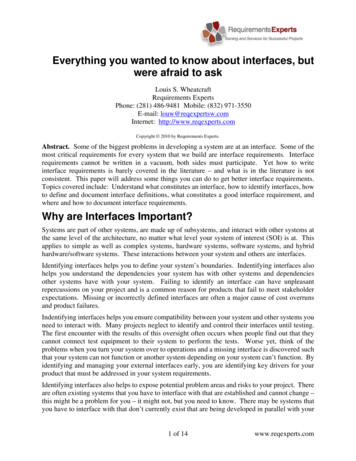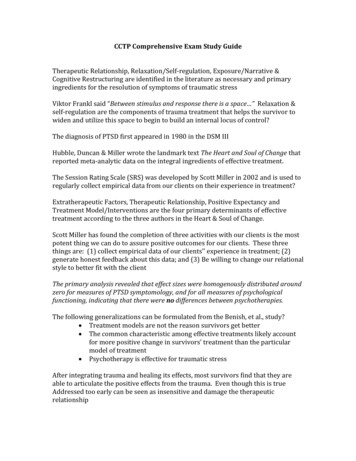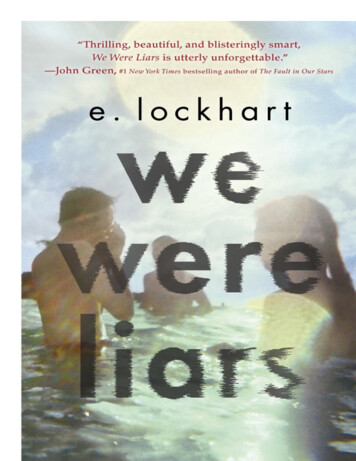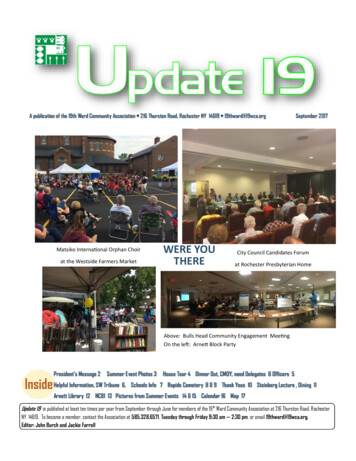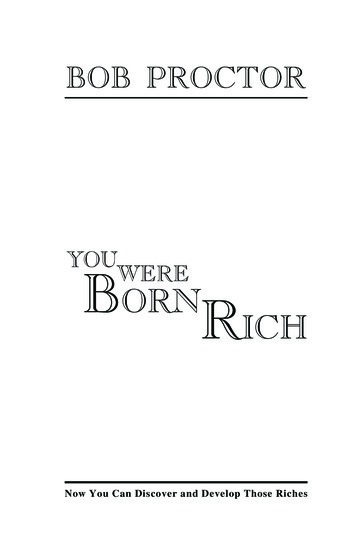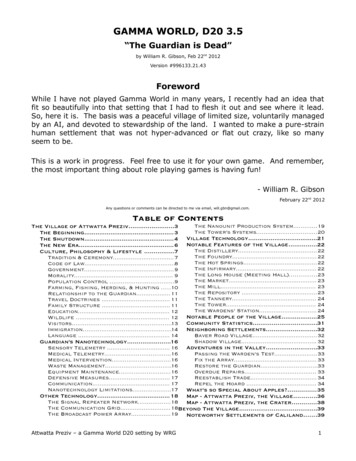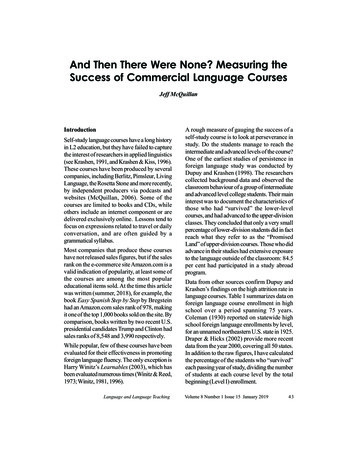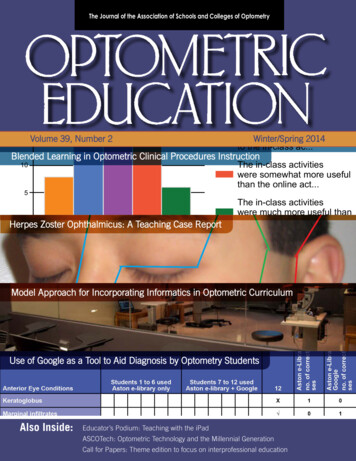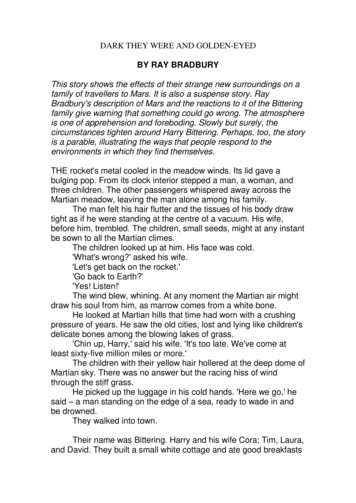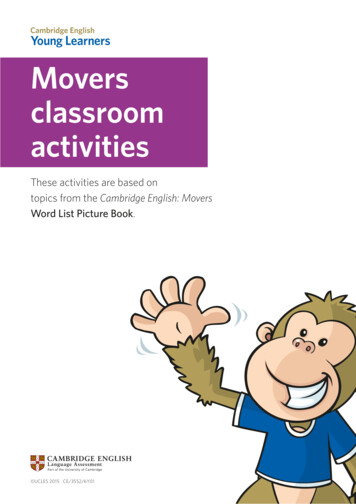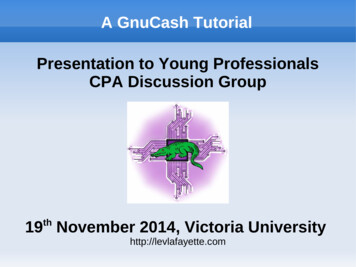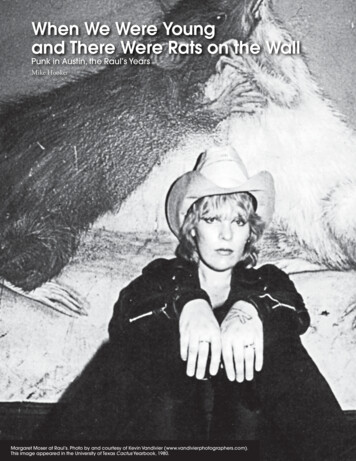
Transcription
When We Were Youngand There Were Rats on the WallPunk in Austin, the Raul’s YearsMike Hooker40Margaret Moser at Raul’s. Photo by and courtesy of Kevin Vandivier (www.vandivierphotographers.com).This image appeared in the University of Texas Cactus Yearbook, 1980.
The formative years of the Austin punk and newwave scene were creative and impactful times.From the beginning of 1978 through the springof 1981, a small club called Raul’s served as thecornerstone of this innovative movement. Raul’swas situated along a section of Guadalupe Streetknown as “the Drag” on the western edge of theUniversity of Texas. Its proximity to campus andthe club’s willingness to give any new band astage on which to perform helped solidify thefoundation of a unified, alternative network of fansand musicians.With a large share of its audience consisting of University of Texas students, the Raul’s sceneexpanded with each new semester as more young people became aware of the excitement withinwalking distance of student housing. At its peak, Raul’s hosted punk shows six nights a week.Many of the dedicated fans that frequented Raul’s eventually formed their own bands, eventhough a large portion of them had no prior musical training. They used their limitations andcreative senses to develop some of the most diverse music and stage shows of the punk rock era.1Austin’s punk scene emerged in the late 1970s, largely as a backlash against the progressivecountry music that had been so prevalent in town earlier in the decade. Disco music dominatedthe national airwaves, and many local teens sought something different that could more accuratelyreflect their changing musical tastes.2 The rallying cry finally came on January 8, 1978, whenone of punk rock’s pioneer bands, the Sex Pistols, played a concert in San Antonio. Carloads ofmusic-starved, impressionable adolescents from Austin made the journey to the Alamo City towitness an event that would ultimately change the direction of music in Central Texas forever.3The Sex Pistols’ legacy was wrought with controversy from the band’s inception in 1975. Bandmembers wore outrageous clothing that was torn and held together with safety pins. They wrotesongs such as “Anarchy In The UK” and “God Save The Queen,” which openly denounced theroyal family. Reports of violence at Sex Pistols shows resulted in the group being banned fromclubs across England.41
Virgin Records released the Sex Pistols’ debut album, NeverMind the Bollocks, on October 28, 1977. A full U.S. tour wasslated to follow, but delays in obtaining work visas resultedin the band’s playing only seven dates, two of which were inTexas. Manager Malcolm McLaren booked the band at countrymusic venues across the southern United States in hopes ofprovoking violent reactions and increased media attention, atactic that worked.4The third stop on the Sex Pistols’ tour took place in SanAntonio on January 8, 1978, in a converted bowling alley calledRandy’s Rodeo. Although there was no more than a one-linemention of the Sex Pistols’ upcoming appearance in the Austinentertainment papers, word quickly spread to those who hadacquired import copies of Sex Pistols records or read about thegroup in papers such as the Village Voice, New York Rocker, orBritain’s New Musical Express (also known as NME).542harm to the band.10 The evening continued without furtherincident, but the excitement and energy of the performance lefta lasting impression on audience members. Among those in thecrowd were several young Austinites who would form some ofthe city’s very first punk bands.11Raul’s OpensIn December 1977, a former Kentucky Fried Chickenrestaurant manager named Roy Gomez bought a club at 2610Guadalupe Street, across from the University of Texas campus.Joseph Gonzales managed the club, and Bobby Morales servedas the bouncer. Previously called Gemini’s, the venue hadfeatured local rock and roll bands.12 When Gomez took over,he rechristened the club “Raul’s” and planned to showcaseChicano music. However, he allowed one of the bands that hadregularly played at Gemini’s, a group known as Project Terror,The third stop on the Sex Pistols’ tour took place in San Antonio onJanuary 8, 1978, in a converted bowling alley called Randy’s Rodeo.The show sold out with a reported 2,200 people in attendance.The majority of the crowd consisted of curious spectators fromSan Antonio. With their unique attire, the punk rockers thatcame from as far as Austin and Houston were easy to discernamong the crowd. There was even a small booth set up in theclub that sold safety pins with the centers removed so fans couldput them in their noses without the pins actually piercing flesh.6From the moment the Sex Pistols took the stage, someaudience members tossed beer cans, plates of pizza, andhomemade cream pies at the band.7 Within minutes the stagewas covered with trash. Some people with cardboard boxesclimbed onstage in what appeared to be an effort to clean upthe mess, but they ran back into the crowd to redistribute thecans so others could continue their attack.8 The audience alsocursed and made obscene gestures at the band. Irritated by thecrowd’s behavior, singer Johnny Rotten lashed back followingthe third number, a song called “Seventeen,” by declaring, “Youcowboys are all faggots.”9Rotten’s remarks further antagonized the crowd, promptinga man near the front of the stage to yell at the singer duringthe next song, “New York.” Rotten ignored the man, who thenbegan taunting bass player, Sid Vicious. As the song ended,Vicious took off his bass, swung it in the air, and struck theman on his shoulder. The man was removed from the buildingand later stated that he did, in fact, intend to cause physicalto continue performing. This largely undocumented groupinadvertently helped pave the way for Raul’s to become thepremier punk rock venue in Austin.13Project Terror’s drummer, Little Stevie Wilson, was dating17-year-old Marilyn Dean, who played drums in a local bandcalled the Violators with guitarists Kathy Valentine and CarlaOlson. The Violators wanted to be an all-girl group, like theRunaways, but were unable to find a suitable female bass player.So, they recruited Jesse Sublett, a bassist who was a friend andformer bandmate of Olson’s boyfriend, Eddie Muñoz. Duringbreaks at Violators rehearsals, Muñoz and Sublett beganjamming. The two had previously played together and decidedto start a new group. They soon added Billy Blackmon ondrums and created the three-piece outfit known as the Skunks.14Through Marilyn Dean’s affiliation with Project Terror, theViolators booked their first gig at Raul’s as an opening act ona Thursday night shortly after the Sex Pistols passed throughTexas. The performance went over well, and Roy Gomezinvited them back to headline a show on Saturday, January28, 1978.15 Since Sublett was performing double-duty as bassplayer in both the Violators and the Skunks, he saw this as anopportunity to get the Skunks their first real gig. The groups’poster, which marked the first of several times the Skunks andViolators would share a stage at Raul’s, declared, “New WaveHits Austin.”
When We Were Young and There Were Rats on the WallPunk in Austin, the Raul’s YearsOn February 17, 1978, the Ramones played Austin’sWhether it was punk or new wave, the Violators and SkunksArmadillo World Headquarters with the Runaways as theplayed music that sounded vastly different from typical Austinopening act. This was the first major punk concert in Austin,bar bands of that period. The Violators had few originaland the large turnout made it clear that there was a strong localcompositions, so they performed songs from such British punkinterest in punk. However, there was still no established clubbands as the Sex Pistols, Damned, and Eddie & the Hot Rods.where punk fans could gather. As a result, Raul’s soon beganThe Violators also played stripped-down renditions of songs byhosting weekly punk shows. In an effort to attract a studentthe Kinks, the Rolling Stones, and the Yardbirds—all performedcrowd, the club placed ads in the University of Texas’s studentwith a snarl and straightforward approach that set them apart16run Daily Texan newspaper.19from most other bands playing cover material. The Skunks, onOn April 22, 1978, promoter John David Bartlett organizedthe other hand, were more of a straight rock band with a largerabattleof the bands that he billed as a “Punk & New Waverepertoire of original music. Singer/bassist Jesse Sublett statedFestival”at a club called New Atlantis on Austin’s Sixth Street.that he wanted to be a rock star and that the Skunks never setThe Skunks, Violators, and Bodysnatchers represented Austin,out to be a punk band. Nevertheless, the Skunks were at theforefront of a new music movement and wouldshare the stage with many of the pioneeringpunk groups that soon followed.The Bodysnatchers, which formed nearthe end of 1977, was the third punk band toperform at Raul’s. Most of the members hadplayed for years in other groups throughoutTexas and California. All but one had seenthe Sex Pistols’ dynamic performance in SanAntonio. Impressed by what they had witnessed,the Bodysnatchers decided to fold the punkaesthetic into the 1960s cover music they werealready playing. Before long, they began writingoriginal punk tunes with such titles as “AreYou Into Destruction?” and “Mama, What’s APunk?”17The Bodysnatchers captured the raw essenceand rage of British punk with their buzz-sawguitars and snarling Johnny Rotten-esque vocals.Much like the Violators, the Bodysnatchersgot their foot in the door at Raul’s through aconnection with Project Terror. Singer LarryJames and bassist Kyle Brock were old friendswith Project Terror frontman Billy Maddox,who added them as an opening act at Raul’s.The other members of the Bodysnatcherswere brothers Ian and Chris Bailey on drumsand guitar, respectively, and lead guitaristTom McMahon. Since they wrote only sevenoriginal songs during their brief existence, theBodysnatchers played many cover tunes. Besidesperforming favorites by the Ramones and theDamned, they also included punk renditions ofsuch 1950s classics as “Summertime Blues” and“Bony Moronie,” along with material by BritishBattle of the Bands poster. Courtesy Mike Hooker.bands, the Yardbirds and the Creation.1843
44The Bodysnatchers. Courtesy Tom McMahon.while Chatterbox came from San Antonio, and the Nervebreakerstravelled from Dallas. Because Kyle Brock of the Bodysnatchershad a prior commitment, Jimmy Pettit filled in on bass. The eventdrew a large crowd, helping further energize the local punk sceneand draw attention to Raul’s, where the Bodysnatchers, Skunks,and Violators already were playing regularly.20 The Nervebreakerswon first prize, while the Violators and Bodysnatchers tied forsecond place.21 Believing they should have won, the Bodysnatcherslater wrote a song called “Battle of the Bands,” which challengedthe Nervebreakers to a rematch with lyrics that proclaimed,“We’ll kill ya!”Soon after the “Punk & New Wave Festival,” the Bodysnatchersand the Skunks began a Monday-night residency at Raul’s, eachband alternating as headliner. Cheap admission and low beerprices regularly brought in large crowds. The Skunks beganrecording songs with Austin radio personality and engineer, JoeGracey, which resulted in some local airplay; however, the banddid not release a record until the following year.22Meanwhile, the Bodysnatchers went into the studio on July14, 1978, to record five original songs with producer Jay AaronPodolnick. The late-night session was recorded live to tape andmixed on the spot. The resulting seven-inch EP marked the firstindependent punk record released in Austin. Despite this, theBodysnatchers broke up soon afterwards.23The Violators also split up that same summer. Kathy Valentineand Carla Olson did not believe the band was making adequateprogress in Austin and decided to relocate to the West Coast.Once in Los Angeles, they formed a band called the Textones,which achieved modest success. Before long, Kathy Valentineleft the group and embarked on a new project that brought hernational prominence. In December 1980, Margot Olavarria,bassist for the popular female group the Go-Go’s, became illwith Hepatitis A, and Valentine was asked to fill in. She went onto play on the group’s three hit albums, which have sold morethan seven million copies.24The Local Press and the Austin Punk SceneIn addition to bands and venues, the local press was helpingpromote punk music in Austin by 1978. Although only one issueever was published, the Austin Vanguard became the first fanproduced publication to focus on the Austin punk scene. Insteadof including the names of writers, editors, or contributors, thefour-page newspaper simply stated, “Published in Texas byTexans.” The Austin Vanguard was the work of Nick West, alsoknown in the local punk scene as Nick Modern or Nick Fury.He later published a popular magazine called Sluggo!, whichset a precedent for other Austin fanzines, including ContempoCulture, Xiphoid Process, and Western Roundup.The front cover of the sole issue of the Austin Vanguard read,“SOMEDAY ALL THE ADULTS WILL DIE!,” and featuredthe tag line, “A Fanzine For The Whole World.” At a cost of15 cents, the paper included reviews of recent releases fromthe Clash, Roky Erickson, the Dils, and the Tom RobinsonBand, as well as an account of the Elvis Costello/Nick Lowe
When We Were Young and There Were Rats on the WallPunk in Austin, the Raul’s Yearsshow at the Municipal Auditorium on May 23, in which Westproclaimed, “I’m surrounded by leaping crazies—AUSTINIS UN-MELLOWING OUT.” In the article “To Be a Punkin Austin,” West wrote, “Prove you are not boring. That’sright. Prove it. Do something exciting. Don’t just talk aboutit. Don’t just look for it. Don’t just stuff it up your nose andhave a 30-minute buzz on it. Do it and do it now. Be a happyindividual again.” West made no specific mention of any localb
Rotten’s remarks further antagonized the crowd, prompting a man near the front of the stage to yell at the singer during the next song, “New York.” Rotten ignored the man, who then began taunting bass player, Sid Vicious. As the song ended, Vicious took off his bass, swung it in the air, and struck the man on his shoulder. The man was .
